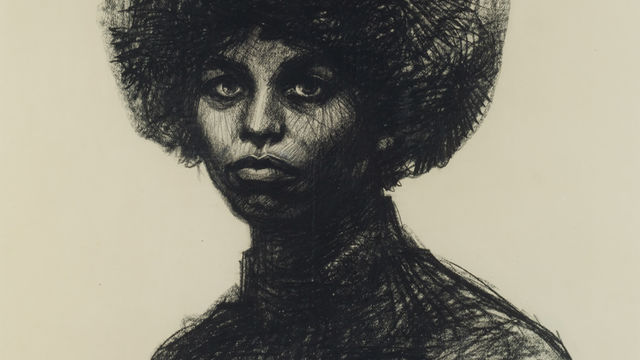
Elizabeth Leigh-Taylor
A native of Los Angeles, Elizabeth Leigh-Taylor graduated from Otis Art Institute in 1962. She was part of a cohort of artists who emerged from the art schools of Los Angeles during this period, along with Ed Bereal and Ed Ruscha (Chouinard), Judy Chicago (UCLA), and Melvin Edwards (USC), among others. Like many of the young artists of the time, she cites Charles White, who later began teaching at Otis, as a major influence. She also drew inspiration from Mexican muralist José Clemente Orozco and German social realist artist Käthe Kollwitz.
Leigh-Taylor was one of the white artists who exhibited at the African American–run Gallery 32, founded in 1968 by fellow Otis art student Suzanne Jackson. Gallery 32 was a multicultural venue that showed a diverse range of artists in Los Angeles, including those who were active supporters of the Black Arts Movement, among them David Hammons, Dan Concholar, Betye Saar, John Outterbridge, Senga Nengudi, Emory Douglas, and Timothy Washington. Leigh-Taylor's work, known for its expressive imagery of figures and faces, was the subject of two provocative solo exhibitions at the gallery that featured charcoal drawings of prominent, outspoken figures in the political struggle for human rights such as Angela Davis. These shows also included images that poignantly depicted the artist's opposition to the U.S.-supported military regime that governed Greece in the late 1960s and early 1970s. The content of Leigh-Taylor's exhibitions drew the attention of the LAPD and the FBI, which frequently surveilled the gallery because of its political affiliations with the Black Panther Party. Addressing the content of her work in 1969, Leigh-Taylor stated, "I'm politically concerned. Concerned with despair, with oppression, with all the things people do to people in the name of God or country or whatever political bag they happen to be in at the moment."# This sentiment makes plain why she was sympathetic to the Black Arts Movement and the struggle for representation among black people both in her hometown and across the United States.
Gallery 32 closed its doors in 1970, but during its two years of operation it made a lasting contribution by providing young artists such as Leigh-Taylor a platform for exhibiting their work. In subsequent decades Leigh-Taylor has had numerous solo and group exhibitions in Los Angeles, including at the Heritage Gallery and the California African American Museum. In 2009 her work was included in Gallery 32 and Its Circle, an exhibition highlighting the importance of the gallery in transforming the cultural landscape of Los Angeles. Leigh-Taylor was a central figure in the climate of "artistic innovation and community activism" that inspired the gallery's mission and defined a cultural moment.#
—Kalia Brooks
Selected Exhibitions
Solo exhibition, Gallery 32, Los Angeles, 1969.
Solo exhibition, Gallery 32, Los Angeles, 1970.
Gallery 32 and Its Circle, Laband Art Gallery, Loyola Marymount University, Los Angeles, 2009.
Selected Bibliography
Peter, Carolyn, and Damon Willick. Gallery 32 and Its Circle. Exh. cat. Los Angeles: Loyola Marymount University, 2009.
Seldis, Henry J., and William Wilson. "Art Walk." Los Angeles Times, November 7, 1969.

